As a member of the Etsy affiliate program and an Amazon Associate, I earn from qualifying purchases.
When you’re new to making healthy, delicious homemade dog treats, it can be HARD to know which recipes to trust and which are nonsense.
Since I’ve been doing this for such a long time, I often forget that what is a basic “duh” moment for me can be totally baffling to someone else. For example, did you know I’ve never shared my recipe for Kol’s favourite dehydrated sweet potato dog treats? Seriously me? Epic. Fail.
To me, it was just something as natural as brushing his fur or snuggling him on chilly nights. I knew my favourite method and it never occurred to me that other people might not be as confident in choosing the right recipe.
That changed when Hannah from Maggie Loves Orbit posted this question in one of our blogging groups.
I bought a dehydrator and already did some meat and chicken feet. I want to try to dehydrate sweet potatoes next. […] The recipes online vary a bit.
Hannah from Maggie Loves Orbit
Some people say to bake it first. Some say to blanche it first. Some say cut and dry. I’m confused lol
What a great question! Why are there so many different methods for making sweet potato dog treats and just how do you know which one is the RIGHT one?
The answer lies in some neato kitchen science. At least I think it’s neato, but I’m also a huge nerd so mileage may vary on how cool you think this post is.
There are generally three recommend ways to make dehydrated sweet potato jerky for your dog:
- Blanche the sweet potato, then dry it
- Just slice the sweet potato and dry it in a dehydrator
- Bake the sweet potato and dry it in the oven
- Roast the sweet potato, then dry it in the oven or a dehydrator
Each method has its own benefits and downfalls. Have you ever bought a bag of sweet potato chews at the pet store and your dog loved them, but then you make them at home and they’re just not interested? Chances are that the company used a different method than you did. Each method creates a chewy sweet potato dog treat with varying levels of sweetness and flavour and chew.
So how do you know which method will produce the type of treat your dog will love best?
We’ve got you covered! We did the testing so you don’t have to.
Method One: Blanche the Sweet Potato, then dry it
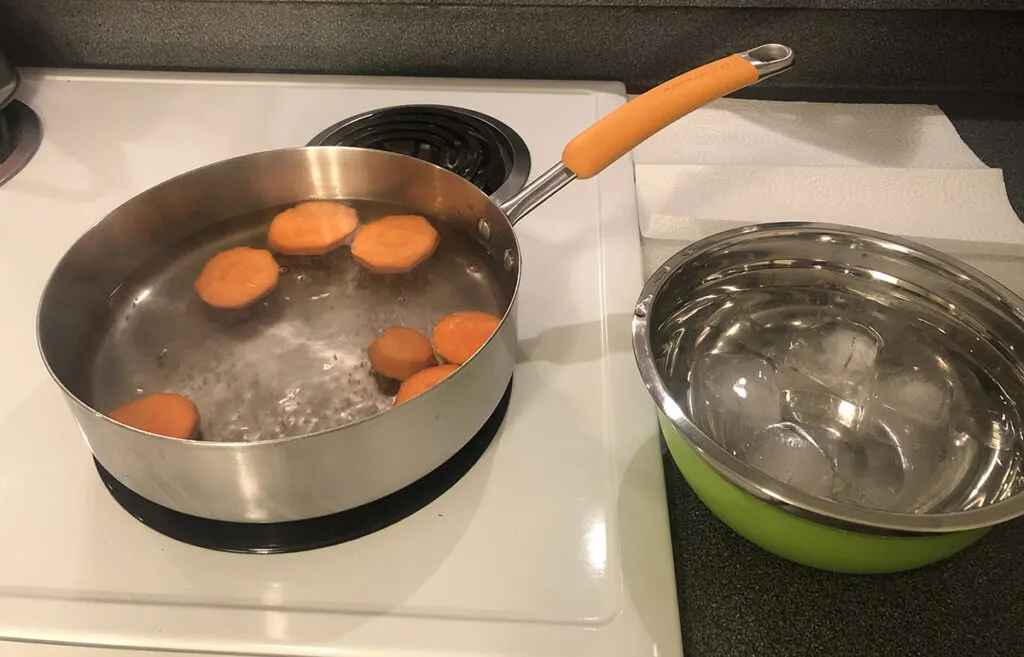
Get the full method and recipe from One Hundred Dollars A Month
PROS: Bright colour, kills bacteria, toughier/sturdy chew
CONS: Multiple steps, less sweet flavour, less tender
When I first started making dog treats in my countertop dehydrator 14 years ago, there wasn’t a lot of information out there. Homemade dog treats were just starting to become a thing people did. To learn how to dehydrate food safely, I turned to people sharing information about preserving food for humans. In human preservation, it’s very common to blanche foods prior to dehydrating them for two reasons.
1. Heat brings out that bright, vibrant colour
2. Blanching can extend the shelf life of your preserved foods by killing off harmful surface bacteria.
Around here, sweet potato chews rarely last long enough that I need to worry about long-term preservation, but if you were batch cooking to store them for use throughout the year, I would definitely recommend this method over the slice & dry method, making sure that you blanche the sweet potato for 3 – 5 minutes to ensure all yucky bacteria is killed off. You can get more sweet potato blanching tips from the Kitchen Professor.
Once the sweet potato has been blanched, shocked, and patted dry with a paper towel or a clean kitchen cloth, you can then transfer it to the oven or the dehydrator.

Blanching doesn’t raise the internal temperature of the sweet potato enough to break down the starches and release that natural sweetness, so while you get that rich sweet potato colour, you get some, but not all of that classic sweet flavour.
Method Two: Slice the sweet potatoes and toss them in a countertop dehydrator
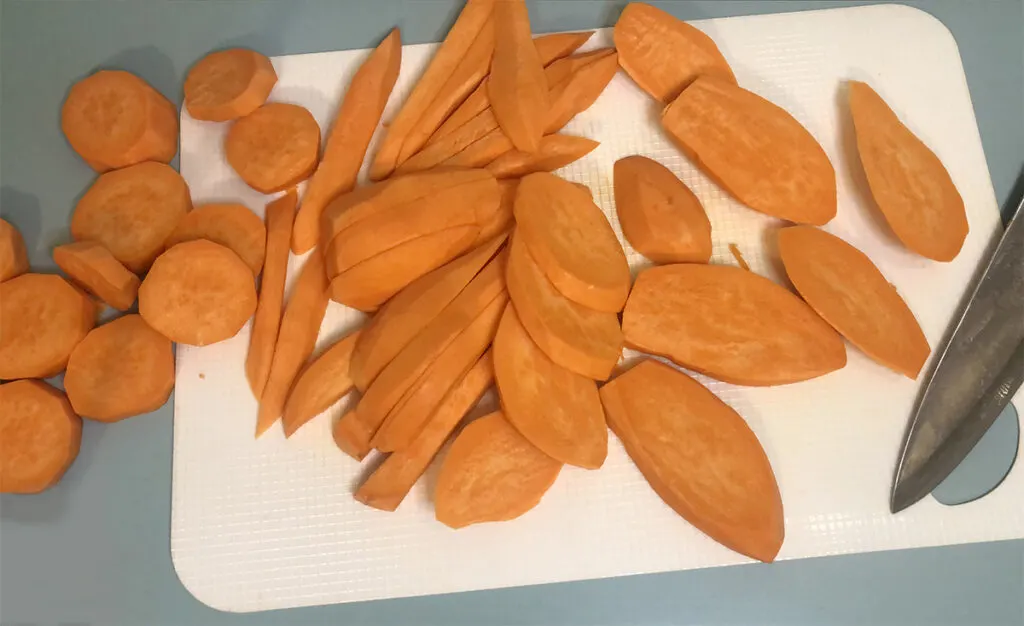
Get the full method and recipe from Three Little Chickpeas
PROS: Easy
CONS: Less sweet flavour, less tender, not hot enough to kill bacteria
While this is absolutely the easiest sweet potato dog treat recipe, it’s also my dog’s least favourite. You can’t beat the ease – just slice your sweet potato and toss it on your dehydrator trays, then forget about it for a while. That’s it. It’s great for people who don’t have a lot of time because it requires only a few minutes of active work and for many dehydrator models, it’s safe to plug them in overnight. (Always check your owner’s manual to see if this is recommended for your dehydrator and ensure it’s placed on a heat-safe surface.)

Sweet potatoes dehydrated from raw are Kolchak’s least favourite style of sweet potato treats – and I can see why. While I will eat the baked chews myself all day long, these tasted really bland and earthy to me. They just lacked that classic SWEET potato flavour.
On the downside, while dehydrators remove moisture from foods reducing the chance of mold; many do not get hot enough to kill off surface bacteria. That means that while the low moisture will slow down spoilage, it won’t prevent it. Your treats can still spoil. Dehydrators don’t usually get hot enough for the natural pectin to tenderize the sweet potato. That can contribute to a less pliable chew. The temperature of a dehydrator also doesn’t always get hot enough to release the natural flavours in the treats leading to a somewhat dull, earthy flavoured chew instead of a sweet one. On the positive side, these offer a lower glycemic option that might be a better diet choice for some pets – and not all dogs are as picky as my very spoiled puggle, so your dog might love them just fine.
Method Three: Bake the sweet potato in the oven until dry
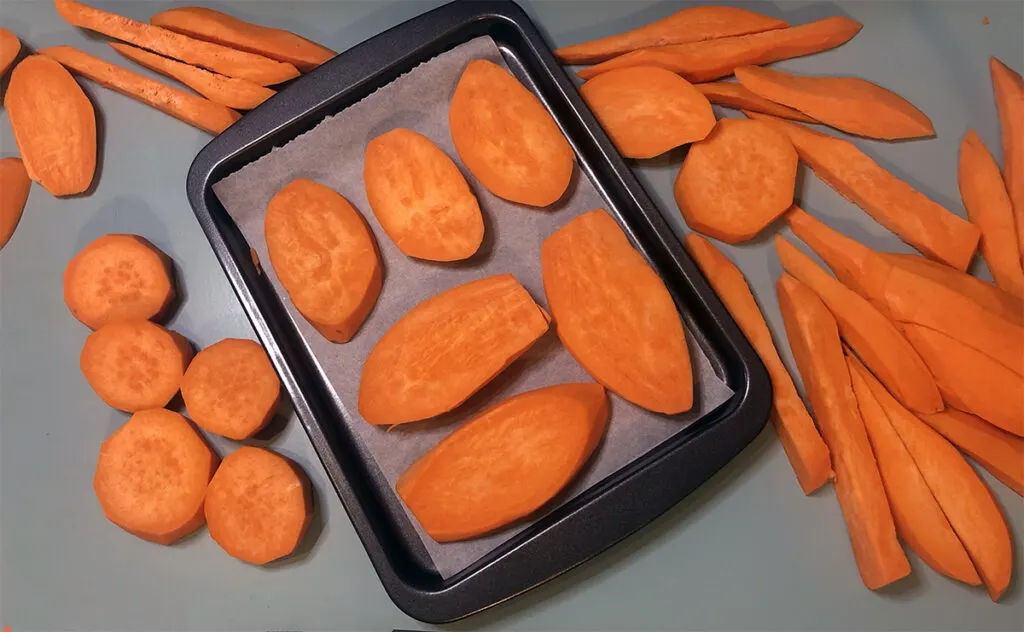
Get the full method and recipe from our friends at My Brown Newfies (one of my fav dog mom resources)
PROS: Bright colour, kills bacteria, sweet flavour
CONS: Leaving your oven on all day, not great for dogs on low sugar/low glycemic diets
This is probably the most popular method for making Sweet Potato jerky for your dog. And it’s popular because it’s SO SIMPLE. There isn’t a ton of prep and it doesn’t take a ton of time. You don’t need any special equipment; most people already have everything they need. Did you know that baked sweet potato has a glycemic index more than double that of raw sweet potato? In fact, baked sweet potato has a higher glycemic index than any other method of preparing a sweet potato. This makes baked sweet potato dog chews a much tastier, richer flavoured chew, but they may not be the best option for dogs with diabetes or other health issues that are managed through a low-glycemic diet.
For this method, make sure you keep your eye on your chews and rotate them as needed to avoid hot spots or burning in your oven.
Method Four: Roast the sweet potatoes, then dry them in a dehydrator
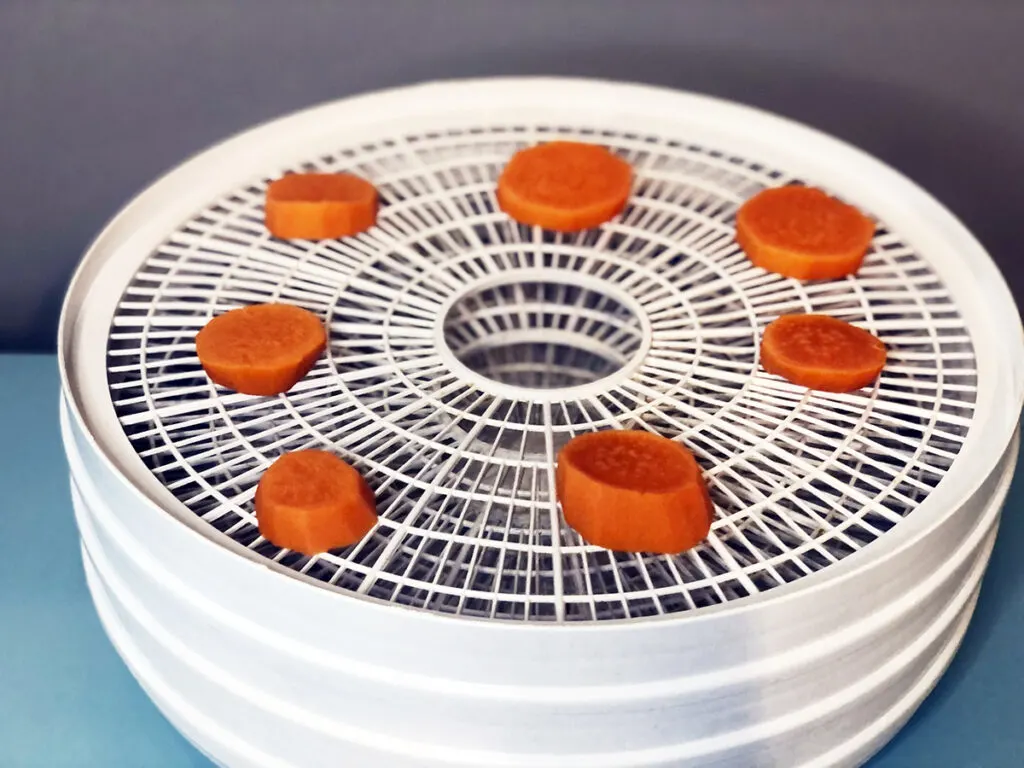
PROS: Sweet flavour, kills off bacteria, don’t have to leave the oven on all-day
CONS: Multiple steps, not great for dogs on low sugar/low glycemic diets
This is the method I use and I use it because it’s the best of both worlds. It’s also how I like to eat my sweet potatoes which means I can make chews for Kol while I prepare my own dinner. I love a task that is literally no extra work! The high heat is enough to release the pectin and tenderize the sweet potato flesh. It also breaks down the starches creating a wonderful, rich, sweet flavour. Transferring the cooked sweet potato to my countertop dehydrator allows me to finish these completely without worrying about leaving my oven on all day.
To me, these are the best of both worlds.
Once you’ve made your sweet potato dog chews from the recipe you and your dog like the most, it’s really important to store them properly in order to keep them unspoiled and safe to eat.
Dehydrating foods can both extend their shelf life and make them easier to store, but that doesn’t mean it is impossible for them to go bad.
So, how do you store dehydrated sweet potato dog chews for optimal shelf life?

- First, make sure your chew are done all the way through. Cut one in half and make sure there is no remaining moisture in the centre. Moisture is what allows mold to thrive.
- Choose an airtight container or vacuum seal your treats if they won’t be used right away.
- Store them in a cool, dark place. I store my sweet potato chews on the shelf for 6 – 12 weeks, but honestly, a batch rarely lasts us that long since both the dog and the hamster, love them.
Did you know that dried sweet potato dog chews are JUST good as treats? I use these for SO many things.
Dehydrating sweet potatoes is just a super-easy way to preserve and store them so they’re always on hand. I use those sweet potatoes in a number of ways.
- Pop a few in water and let soak until rehydrated to make a great soft kibble topper. I do this when Kol is feeling a little fussy and might want some extra OOMPH on his dinner.
- Rehydrate in water, mix with a little kibble dust to make a thick “paste” perfect for forming around pills or meds.
- Rehydrate, puree in the blender, and use in dog treat recipes in place of boiled sweet potato or canned pumpkin
What do you do if your dog isn’t a HUGE fan of dehydrated sweet potato chews?
So many commercially made dog treats are specifically designed to pack a lot of flavour so your dog will LOVE them. Sometimes when you switch to healthier homemade versions it can be a real struggle to get them to make the change. Never fear, with a few small adjustments, you can absolutely win your dog over!
- Boil the sweet potato in a pot with a protein they love like a piece of chicken or liver. The flavour will cook into the sweet potato making it more tantalizing to your dog’s sense of smell.
- After slicing, drege your sweet potato in water, then coat with powdered liver treats (I love Purebites freeze dried treats for this)
- If you’ve already made a big batch that you’re trying to salvage, I gotchoo Booboo. Simply spread a thin coat of canned food or peanut butter onto the surface of a chew when you serve it. This is my fool proof way to get Kol super interested.
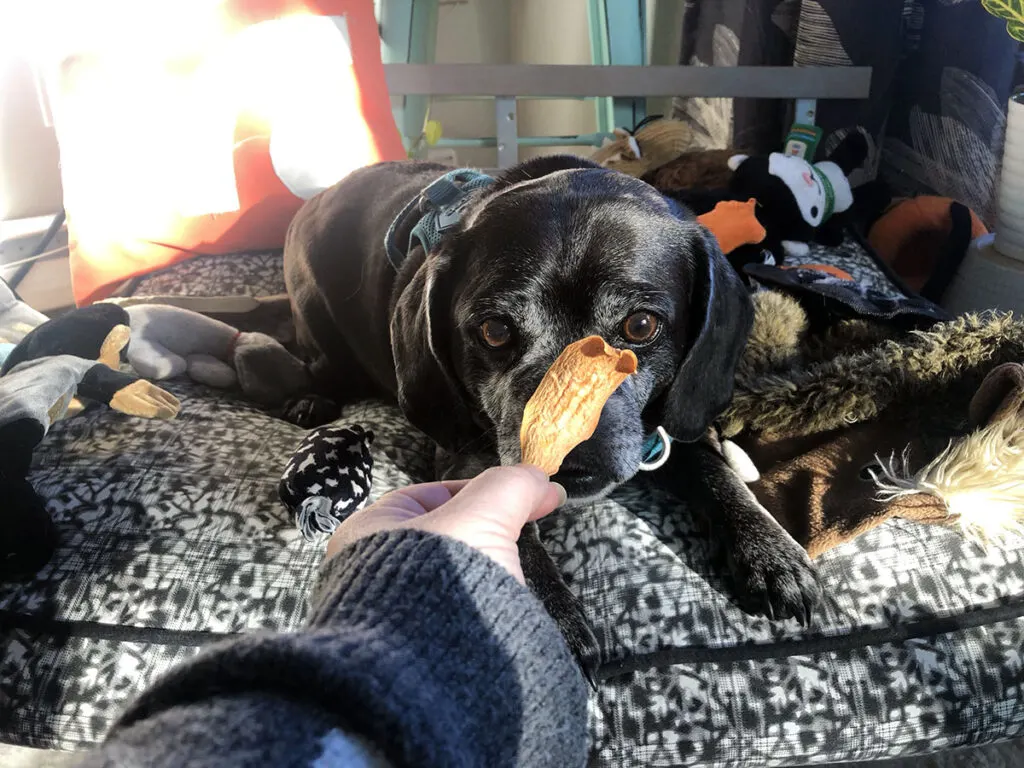
Have you ever made dehydrated sweet potato treats for your dog? What did they think?
Which recipe is your go to? Do you have any tips to share?


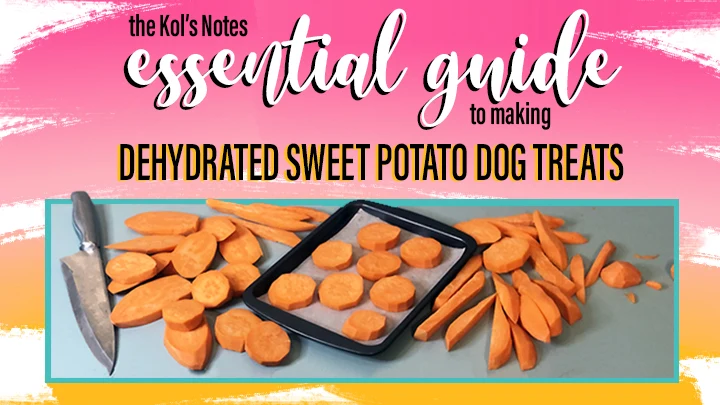
Denise Glassner
Wednesday 1st of November 2023
Hi. I see the method that you use but I don’t see instructions for how to do it (time, temperature, thickness for both roasting and dehydrating. Please help!
Jodi
Sunday 10th of December 2023
Hi Denise, Thanks for dropping by! Under each recipe type, there's a line that says where to get the full recipe: ex. Get the full method and recipe from One Hundred Dollars A Month. If you clickon the One Hundred Dollars a Month, it willtake you to the full instructions :)
Sarwar Abdullah
Sunday 11th of December 2022
I love this idea! Thank you for posting this article, my service dog loves sweet potatoes.